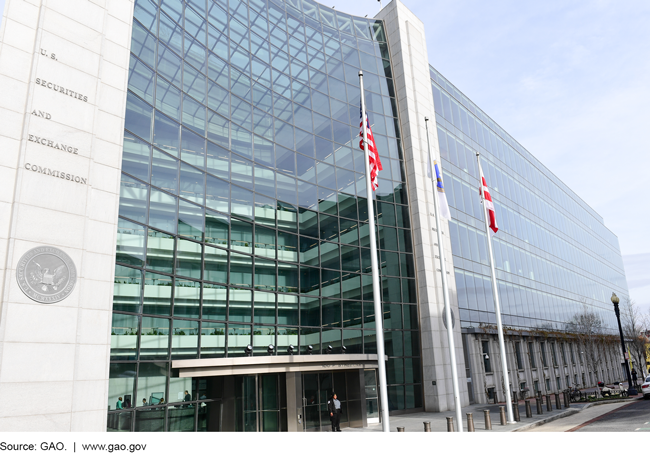Supplemental Material for GAO-20-208: SEC Personnel Survey Results
Fast Facts
This is a supplement to our report, Securities and Exchange Commission: Personnel Management Shows Improvement, but Action Needed on Performance Management System, GAO-20-208. It provides the results from our web-based surveys of employees on their views about SEC’s organizational culture and other aspects of working there, such as training, intra-agency communication, leadership, and performance management.
We surveyed mission-critical employees—877 nonexecutives and 80 senior officers. About two-thirds of each responded to the surveys.

Front of the Securities and Exchange Commission building
Highlights
This supplement is a companion to GAO’s report entitled Securities and Exchange Commission: Personnel Management Shows Improvement, but Action Needed on Performance Management System, GAO-20-208. The purpose of this supplement is to provide results from two GAO web-based surveys of Securities and Exchange Commission (SEC) employees. The purpose of these surveys was to obtain employees’ views on SEC’s organizational culture and on various aspects of working at SEC, including questions on (1) personnel management issues related to recruitment, training, staff development, and resources; (2) communication among and within divisions and offices; (3) leadership and management; (4) performance management and promotions; and (5) organizational culture and climate. The surveys included both multiple-choice and open-ended questions.
Supplemental Material
Background
This supplemental material presents the results from two GAO web-based surveys of Securities and Exchange Commission (SEC) employees. The purpose of these surveys was to obtain employees’ views on SEC’s organizational culture and on various aspects of working at SEC, including questions on (1) personnel management issues related to recruitment, training, staff development, and resources; (2) communication among and within divisions and offices; (3) leadership and management; (4) performance management and promotions; and (5) organizational culture and climate. Our surveys included both multiple-choice and open-ended questions. See GAO-20-208 for a more detailed discussion of our scope and methodology, as well as a discussion of survey results.
We administered two surveys to different employee groups at SEC, as described below. Both employee groups’ surveys generally covered the same topic areas, although some questions differed among surveys based on what was relevant to that group. To minimize the risk of identifying individual respondents, all responses to open-ended questions and responses to categorical questions with a margin of error greater than 15 percentage points at the 95 percent level of confidence are not reported. Respondents' division, location, and supervisory status were self-reported in the survey.
(a) Nonexecutive mission-critical employees. We administered the first survey to a stratified random sample of 877 nonexecutive employees in mission-critical occupations in mission-critical divisions and offices. SEC has designated five occupations—attorneys, accountants, examiners, economists and information technology specialists—as mission-critical because they reflect SEC’s primary mission and because mission‐critical work cannot be completed without them. SEC has also designated four offices and five divisions—the Offices of Compliance Inspections and Examinations, Information Technology, Credit Ratings, and the Chief Accountant, and the Divisions of Corporation Finance, Enforcement, Investment Management, Economic and Risk Analysis, and Trading and Markets—as mission-critical because they are primarily responsible for implementing the agency’s mission. Our survey population for the nonexecutive mission-critical employees consisted of employees who were employed at SEC as of September 30, 2018, according to SEC data. We administered the survey to nonsupervisory and supervisory mission-critical employees from March 2019 through April 2019. A total of 563 of the 877 nonsupervisors and supervisors in the mission-critical divisions and offices responded to our survey for a response rate of 64 percent. We carried out a statistical nonresponse bias analysis for the survey of mission-critical employees using available administrative data and determined that the results are generalizable to SEC’s mission-critical employees. Because we used a sample methodology, the results for the nonexecutive employees are presented as estimated percentages with 95 percent confidence intervals.
- Click here to view the questionnaire for nonexecutive mission-critical employees
- Click here to view the results of the questionnaire for nonexecutive mission-critical employees
(b) Senior officers in mission-critical divisions and offices. We administered the second survey from March 2019 through May 2019 to all 80 senior officers in mission-critical divisions and offices—specifically, those at the SO-1, SO-2, and SO-3 pay grades. Our population for the survey consisted of employees who were employed at SEC as of September 30, 2018, according to SEC data. A total of 50 of the 80 senior officers responded to our survey for a response rate of 63 percent. We do not attempt to extrapolate the findings of our senior officer survey to the 37 percent of the senior officers in mission-critical divisions and offices who chose not to complete our survey.
- Click here to view the questionnaire for senior officers in mission-critical divisions and offices
- Click here to view the results of the questionnaire for senior officers in mission-critical divisions and offices
We conducted the work upon which this supplement is based from August 2018 to January 2020 in accordance with generally accepted government auditing standards. Those standards require that we plan and perform the audit to obtain sufficient, appropriate evidence to provide a reasonable basis for our findings and conclusions based on our audit objectives. We believe that the evidence obtained provides a reasonable basis for our findings and conclusions based on our audit objectives.
